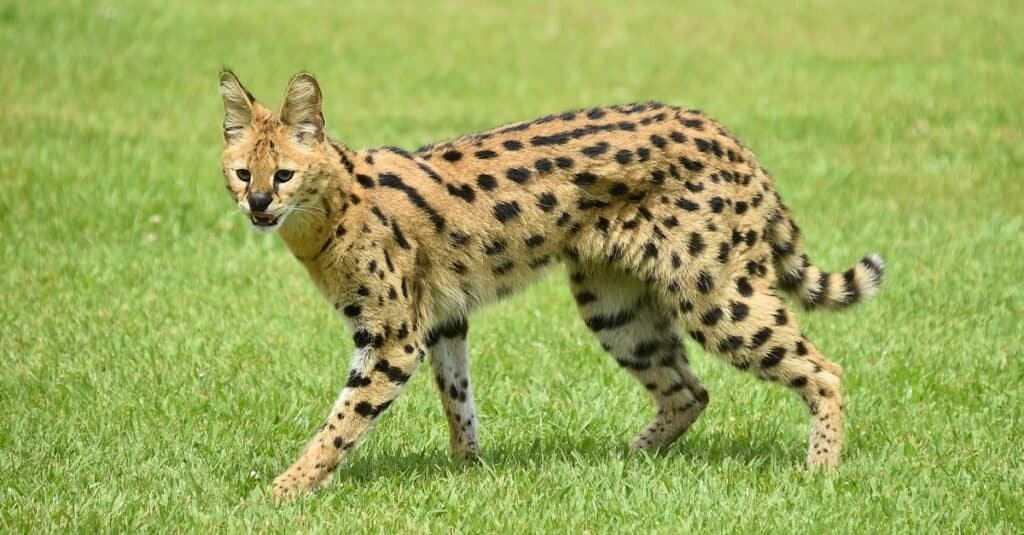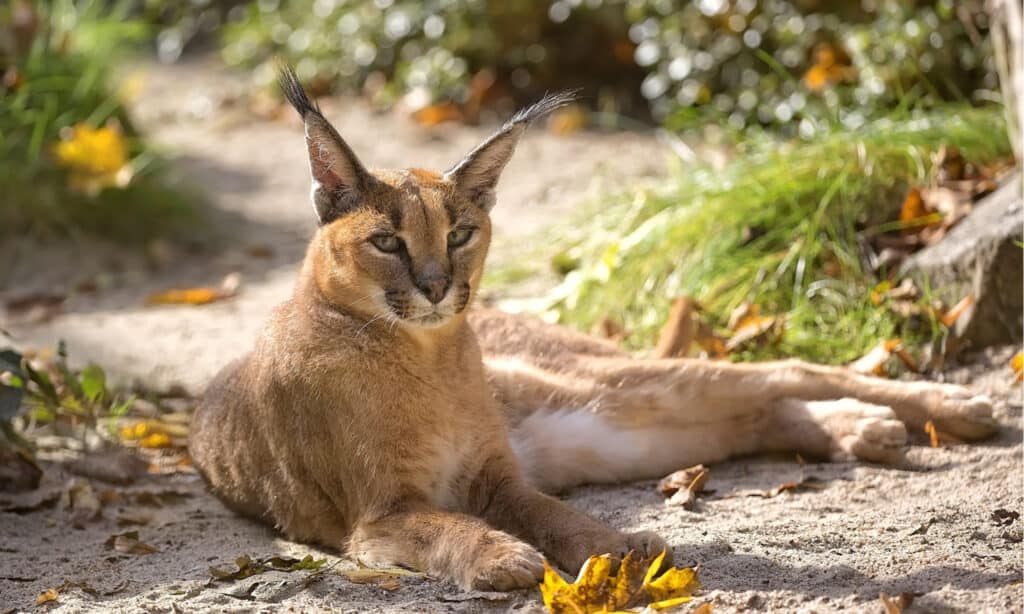Caracal vs Serval: Key Differences Explained
@media (min-width: 481px) {
.mobile-top-content {
display: none;
}
}
#mobileTopContentCTACarouselControls { overflow: hidden; text-overflow: ellipsis; white-space: nowrap; }
.mobile-top-content .more { color: #fff; }
.mobile-top-content a { color: #fff; text-decoration: underline; }
.mobile-top-content a:hover { color: #fff; text-decoration: underline; }
@media (max-width: 480px) {
.mobile-top-content {
background-color: #06a10b;
color: #fff;
text-align: center;
/*height: 60px;
padding-top:5px;*/
font-size:80%;
/* display: block; */
margin: 0px -30px;
}
}
Africa is home to some of the most amazing predators on earth, with many regarding cats as the top hunters around. Whether big or small, cats are efficient and deadly hunters that can take down prey multiple times their size. In Africa, two of the top feline predators are the caracal and the serval. Although they are very similar in a lot of ways, there are some distinct differences between them. Today, let’s explore the differences between the Caracal vs Serval and see what makes them unique.
Let’s get started!
Comparing a Caracal and a Serval

A-Z-Animals.com
| Caracal | Serval | |
|---|---|---|
| Pattern and color | Golden brown or tan. Solid coat with no spots or stripes. | Golden yellow. Black spots and stripes across the body. |
| Ear tufts | Large ear tufts. | No ear tufts. |
| Active hours | Nocturnal | Dawn, dusk, day. |
| Hunting habitat | Dry savannah, semi-arid environments. | Wetter environments. Bamboo, reeds, marshlands. |
| Preferred prey size | Mostly small mammals but can hunt larger antelope. | 90% of prey is 200 grams or less. |
| Distribution | Sub-Saharan Africa, Middle East, Asia | Sub-Saharan Africa. |
The 6 main differences between a caracal and a serval
The main difference between a caracal and a serval is that caracals are golden brown, have black ear tufts, and occupy a larger range. Servals are yellow with black spots, don’t have ear tufts, and occupy a smaller range than the caracal.
Both the caracal and the serval are medium-sized cats, although they are generally referred to as “small cats” when talking about them. When compared to a lion or tiger, it makes more sense! Still, between them, the caracal is slightly larger and more powerful than the serval is, although this difference isn’t major.
From an evolutionary standpoint, these two cats are closely related. While they are both felines, they seem to have a common ancestor that isn’t too distant. Current data listed the common ancestor between the two, living sometime around 8.5 million years ago. Still, there are some distinct differences that have evolved between them since their split.
Let’s take a look at these differences in some more detail below.
Caracal vs Serval: Pattern and color

alberto clemares exposito/Shutterstock.com
The easiest way to identify between a caracal and a serval is their color. Although they are similar cats in many ways, they don’t look similar to one another at all. Caracals are tan or golden brown cats with no patterns across their bodies. Their ears are black and white, and they have some black coloration across their mouths, but aside from that, they are solid colored. In fact, they look extremely similar to the North American lynx, although the caracal is thinner and more elongated.
Servals are beautiful cats characterized by their light golden body and black spotted pattern. They have a white underbelly and inner legs. Their spotted pattern can sometimes morph into stripes in certain areas across their bodies. There are examples of these cats coming in leucistic and melanistic morphs in the wild and captivity, but these individuals are quite rare. The serval looks extremely similar to an ocelot when it comes to its pattern, but the serval is much lankier and lighter in color than the ocelot.
Caracal vs Serval: Ear tufts

Janusz Pienkowski/Shutterstock.com
Another visible differentiator between the two is the presence of ear tufts. Caracals have distinct ear tufts that are normally black and white. These ear tufts extend a few inches past the ear and are visible from all sides of the cat. There isn’t total consensus on the purpose of these ear tufts, but some theories state that they are used for communication, keeping insects away from the ears and eyes, and breaking up the cat’s outline in the grass. In fact, the caracal gets its name from a Turkish word that translates as “black-eared.”
The serval doesn’t have any distinct ear tufts as the caracal does. One other feature, however, is simply how large their ears are in relation to their head. The ears of the serval are rather large and can be moved around in order to listen for prey. Additionally, serval ears are often striped with a black or white streak.
Caracal vs Serval: Active hours

The caracal is primarily a nocturnal animal, meaning that it is most active when the sun has set. Still, there are some examples where caracals have come out during the day as they can be active when the need arises. Some studies show that they are generally more active when the temperatures decrease below 68 °F.
The serval is more varied in the hours that it is active. Most servals are active during the day and the night, depending on the day. Generally, serval activity peaks in midmorning and at dusk and midnight. When the weather is cooler, servals are more likely to be active. During the hottest parts of the day, servals will rest in the shade, as many other predators do.
Caracal vs Serval: Hunting habitat

Caracals are superb hunters that can take prey of all sorts. The habitat that they generally hunt in, however, is different than that of the serval. Most caracals hunt in the dry areas of Africa and the Middle East to hunt. Grasslands, deep brush, and semi-arid regions are ideal for the caracal, especially since their coat better camouflages them in these regions.
Servals hunt in wetter habitats than most caracals do. Although they have a somewhat similar prey list, servals are better adapted to hunt around water. These cats can often hunt in grasslands, bamboo thickets, wetlands, and savannas (primarily near the presence of reeds).
Caracal vs Serval: Preferred prey size

iStock.com/StuPorts
Caracals are more powerful than servals and are therefore able to take larger prey. The most common prey are small mammals, birds, and rodents. Additionally, caracals have no problem taking down duiker, sheep, goats, and even large antelope. A caracal can take down prey up to three times its size.
Servals are also superb hunters, but their primary prey source is generally smaller. The serval has a diet that is 90% composed of animals that weigh less than 200 grams. Their most common foods are vlei rats, small birds, and frogs. Still, they will occasionally prey on duiker, hares, and small (young) antelopes.
Caracal vs Serval: Distribution
The caracal is mostly found in sub-Saharan Africa and across the Middle East. They do live in North Africa but are far less common. Across their range, three subspecies of caracal exist:
- Southern caracal (C. c. caracal)
- Northern caracal (C. c. nubicus)
- Asiatic caracal (C. c. schmitzi)
The serval is also found in sub-Saharan Africa, but they are not found in the Middle East or Asia as the caracal is. There are three subspecies currently recognized:
- L. s. serval
- L. s. constantina
- L. s. lipostictus
More from A-Z Animals
.more-snake-card-image { max-height:140px !important; }
@media (min-width: 481px) {
.mobile-top-content {
display: none;
}
}
#mobileTopContentCTACarouselControls { overflow: hidden; text-overflow: ellipsis; white-space: nowrap; }
.mobile-top-content .more { color: #fff; }
.mobile-top-content a { color: #fff; text-decoration: underline; }
.mobile-top-content a:hover { color: #fff; text-decoration: underline; }
@media (max-width: 480px) {
.mobile-top-content {
background-color: #06a10b;
color: #fff;
text-align: center;
/*height: 60px;
padding-top:5px;*/
font-size:80%;
/* display: block; */
margin: 0px -30px;
}
}
Africa is home to some of the most amazing predators on earth, with many regarding cats as the top hunters around. Whether big or small, cats are efficient and deadly hunters that can take down prey multiple times their size. In Africa, two of the top feline predators are the caracal and the serval. Although they are very similar in a lot of ways, there are some distinct differences between them. Today, let’s explore the differences between the Caracal vs Serval and see what makes them unique.
Let’s get started!
Comparing a Caracal and a Serval

A-Z-Animals.com
| Caracal | Serval | |
|---|---|---|
| Pattern and color | Golden brown or tan. Solid coat with no spots or stripes. | Golden yellow. Black spots and stripes across the body. |
| Ear tufts | Large ear tufts. | No ear tufts. |
| Active hours | Nocturnal | Dawn, dusk, day. |
| Hunting habitat | Dry savannah, semi-arid environments. | Wetter environments. Bamboo, reeds, marshlands. |
| Preferred prey size | Mostly small mammals but can hunt larger antelope. | 90% of prey is 200 grams or less. |
| Distribution | Sub-Saharan Africa, Middle East, Asia | Sub-Saharan Africa. |
The 6 main differences between a caracal and a serval
The main difference between a caracal and a serval is that caracals are golden brown, have black ear tufts, and occupy a larger range. Servals are yellow with black spots, don’t have ear tufts, and occupy a smaller range than the caracal.
Both the caracal and the serval are medium-sized cats, although they are generally referred to as “small cats” when talking about them. When compared to a lion or tiger, it makes more sense! Still, between them, the caracal is slightly larger and more powerful than the serval is, although this difference isn’t major.
From an evolutionary standpoint, these two cats are closely related. While they are both felines, they seem to have a common ancestor that isn’t too distant. Current data listed the common ancestor between the two, living sometime around 8.5 million years ago. Still, there are some distinct differences that have evolved between them since their split.
Let’s take a look at these differences in some more detail below.
Caracal vs Serval: Pattern and color

alberto clemares exposito/Shutterstock.com
The easiest way to identify between a caracal and a serval is their color. Although they are similar cats in many ways, they don’t look similar to one another at all. Caracals are tan or golden brown cats with no patterns across their bodies. Their ears are black and white, and they have some black coloration across their mouths, but aside from that, they are solid colored. In fact, they look extremely similar to the North American lynx, although the caracal is thinner and more elongated.
Servals are beautiful cats characterized by their light golden body and black spotted pattern. They have a white underbelly and inner legs. Their spotted pattern can sometimes morph into stripes in certain areas across their bodies. There are examples of these cats coming in leucistic and melanistic morphs in the wild and captivity, but these individuals are quite rare. The serval looks extremely similar to an ocelot when it comes to its pattern, but the serval is much lankier and lighter in color than the ocelot.
Caracal vs Serval: Ear tufts

Janusz Pienkowski/Shutterstock.com
Another visible differentiator between the two is the presence of ear tufts. Caracals have distinct ear tufts that are normally black and white. These ear tufts extend a few inches past the ear and are visible from all sides of the cat. There isn’t total consensus on the purpose of these ear tufts, but some theories state that they are used for communication, keeping insects away from the ears and eyes, and breaking up the cat’s outline in the grass. In fact, the caracal gets its name from a Turkish word that translates as “black-eared.”
The serval doesn’t have any distinct ear tufts as the caracal does. One other feature, however, is simply how large their ears are in relation to their head. The ears of the serval are rather large and can be moved around in order to listen for prey. Additionally, serval ears are often striped with a black or white streak.
Caracal vs Serval: Active hours

The caracal is primarily a nocturnal animal, meaning that it is most active when the sun has set. Still, there are some examples where caracals have come out during the day as they can be active when the need arises. Some studies show that they are generally more active when the temperatures decrease below 68 °F.
The serval is more varied in the hours that it is active. Most servals are active during the day and the night, depending on the day. Generally, serval activity peaks in midmorning and at dusk and midnight. When the weather is cooler, servals are more likely to be active. During the hottest parts of the day, servals will rest in the shade, as many other predators do.
Caracal vs Serval: Hunting habitat

Caracals are superb hunters that can take prey of all sorts. The habitat that they generally hunt in, however, is different than that of the serval. Most caracals hunt in the dry areas of Africa and the Middle East to hunt. Grasslands, deep brush, and semi-arid regions are ideal for the caracal, especially since their coat better camouflages them in these regions.
Servals hunt in wetter habitats than most caracals do. Although they have a somewhat similar prey list, servals are better adapted to hunt around water. These cats can often hunt in grasslands, bamboo thickets, wetlands, and savannas (primarily near the presence of reeds).
Caracal vs Serval: Preferred prey size

iStock.com/StuPorts
Caracals are more powerful than servals and are therefore able to take larger prey. The most common prey are small mammals, birds, and rodents. Additionally, caracals have no problem taking down duiker, sheep, goats, and even large antelope. A caracal can take down prey up to three times its size.
Servals are also superb hunters, but their primary prey source is generally smaller. The serval has a diet that is 90% composed of animals that weigh less than 200 grams. Their most common foods are vlei rats, small birds, and frogs. Still, they will occasionally prey on duiker, hares, and small (young) antelopes.
Caracal vs Serval: Distribution
The caracal is mostly found in sub-Saharan Africa and across the Middle East. They do live in North Africa but are far less common. Across their range, three subspecies of caracal exist:
- Southern caracal (C. c. caracal)
- Northern caracal (C. c. nubicus)
- Asiatic caracal (C. c. schmitzi)
The serval is also found in sub-Saharan Africa, but they are not found in the Middle East or Asia as the caracal is. There are three subspecies currently recognized:
- L. s. serval
- L. s. constantina
- L. s. lipostictus









